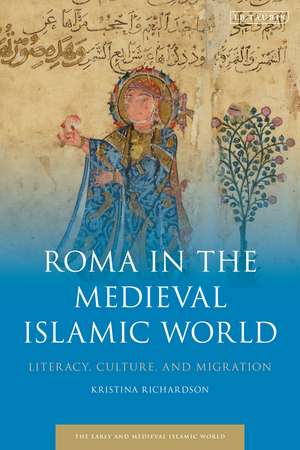Roma in the Medieval Islamic World: Literacy, Culture, and Migration: Early and Medieval Islamic World
Autor Kristina Richardsonen Limba Engleză Paperback – 30 noi 2022
| Toate formatele și edițiile | Preț | Express |
|---|---|---|
| Paperback (1) | 135.20 lei 3-5 săpt. | +53.84 lei 7-13 zile |
| Bloomsbury Publishing – 30 noi 2022 | 135.20 lei 3-5 săpt. | +53.84 lei 7-13 zile |
| Hardback (1) | 540.07 lei 6-8 săpt. | |
| Bloomsbury Publishing – 15 dec 2021 | 540.07 lei 6-8 săpt. |
Preț: 135.20 lei
Preț vechi: 173.69 lei
-22% Nou
Puncte Express: 203
Preț estimativ în valută:
25.87€ • 27.16$ • 21.47£
25.87€ • 27.16$ • 21.47£
Carte disponibilă
Livrare economică 20 martie-03 aprilie
Livrare express 06-12 martie pentru 63.83 lei
Preluare comenzi: 021 569.72.76
Specificații
ISBN-13: 9780755635818
ISBN-10: 0755635817
Pagini: 256
Dimensiuni: 156 x 234 x 20 mm
Greutate: 0.4 kg
Editura: Bloomsbury Publishing
Colecția I.B.Tauris
Seria Early and Medieval Islamic World
Locul publicării:London, United Kingdom
ISBN-10: 0755635817
Pagini: 256
Dimensiuni: 156 x 234 x 20 mm
Greutate: 0.4 kg
Editura: Bloomsbury Publishing
Colecția I.B.Tauris
Seria Early and Medieval Islamic World
Locul publicării:London, United Kingdom
Caracteristici
Provides a glossary of premodern Sin
Notă biografică
Kristina Richardson is Associate Professor of History at Queens College and the Graduate Center of the City University of New York, USA. She is the author of Difference and Disability in the Medieval Islamic World (2012) and co-editor of a 16th-century Syrian weaver's notebook (forthcoming). She also serves as an editor for the journal Der Islam.
Cuprins
List of FiguresList of TablesAcknowledgments Abbreviations Introduction 1. The Roma, Banu Sasan, and the Ghuraba'2. Sin: The Language of the Banu Sasan and Ghuraba'3. Gharib Literary Cultures in Mamluk Cairo4. Housing, Neighborhoods, and Cemeteries of Urban Ghuraba'5. Illustrated Astrological Books (Bulhans)6. A New Narrative of Premodern Afro-Eurasian Printing7. Ghuraba' Astrologers and Print in 15th-Century Central Europe Appendix 1: Appendix 2: Glossary Notes Bibliography Index
Recenzii
This book is nothing short of a radical remapping of the Global Middle Ages that decenters sedentary peoples and refuses territorial partition. Kristina Richardson brilliantly illuminates the sophisticated literary, technological, and intellectual cultures of the Ghuraba' (Strangers), the Roma, and other traveling communities as they moved along the margins of Afro-Eurasian societies between the eighth and the sixteenth centuries. Methodologically wide-ranging and analytically bold, Roma in the Medieval Islamic World will change the way we write medieval history.
Fascinating! Like watching a wonderful and unexpected landscape emerge as a master jigsaw puzzler fits the pieces together.
"In this brilliant work, Dr. Kristina Richardson illustrates the fundamental importance of studying peoples that transcend geographical and cultural boundaries. Attention to the 'marginal' Ghuraba' across time and space shows them to be anything one of the major groups responsible for facilitating Afro-Eurasian cultural exchange. Of the many notable contributions of this work, her intervention in the history of the printed book is a stunning contribution to the field. Through meticulous linguistic and material analysis, she shows that the Ghuraba' are the most likely candidates for the transmission of 'print culture' from East Asia to the West. Her findings are sure to win many converts and provide a new methodological approach for exploring the vital importance of minority groups to the emergence of Afro-Eurasian material cultures."
Fascinating! Like watching a wonderful and unexpected landscape emerge as a master jigsaw puzzler fits the pieces together.
"In this brilliant work, Dr. Kristina Richardson illustrates the fundamental importance of studying peoples that transcend geographical and cultural boundaries. Attention to the 'marginal' Ghuraba' across time and space shows them to be anything one of the major groups responsible for facilitating Afro-Eurasian cultural exchange. Of the many notable contributions of this work, her intervention in the history of the printed book is a stunning contribution to the field. Through meticulous linguistic and material analysis, she shows that the Ghuraba' are the most likely candidates for the transmission of 'print culture' from East Asia to the West. Her findings are sure to win many converts and provide a new methodological approach for exploring the vital importance of minority groups to the emergence of Afro-Eurasian material cultures."












